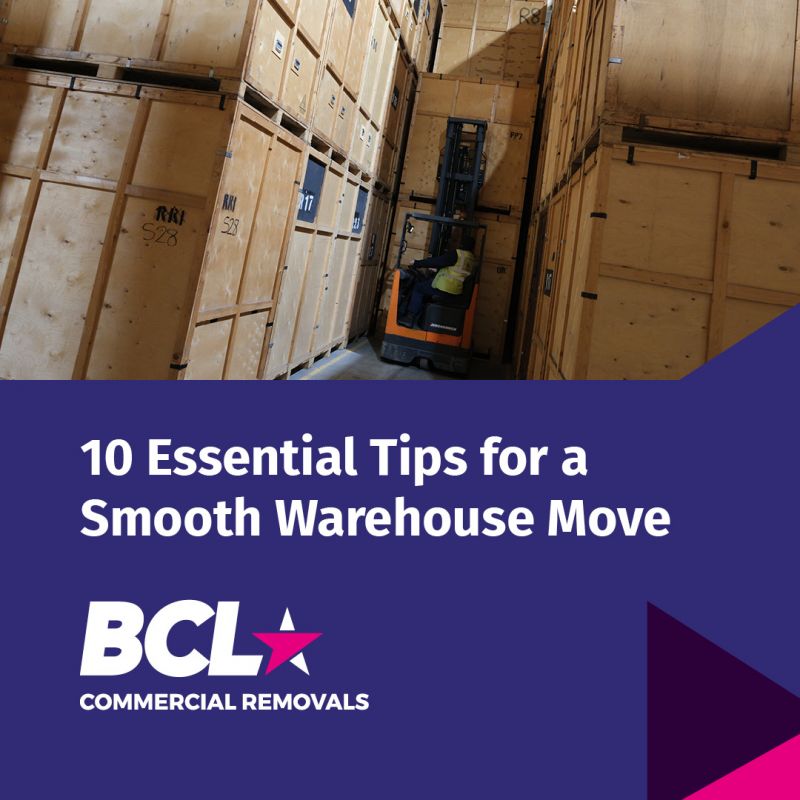10 Essential Tips for a Smooth Warehouse Move
Mon 17th March 2025Relocating a warehouse is a major undertaking that requires careful planning and execution. A well-organised move can improve efficiency, optimise storage, and even reduce long-term operational costs.
Our team in Stafford have vast experience of helping many Staffordshire and the surrounding region’s numerous manufacturing and distribution businesses make the move to new premises. We asked our expert team in warehouse moves in Stafford and Staffordshire to give us their top tips for a successful move.
Whether you're upgrading to a larger facility, consolidating locations, or shifting to a more strategic site, these 10 essential tips will help you achieve a seamless and successful warehouse move.
1. Start Planning Early for a Stress-Free Transition
The key to a smooth warehouse move is early and thorough planning. Develop a detailed relocation timeline well in advance, considering factors such as peak business periods, supplier schedules, and staffing availability. Assign roles to key team members and establish clear deadlines to keep everything on track.
2. Conduct a Full Inventory Audit for Better Organisation
A warehouse move is the perfect time to assess and optimise your inventory. Conduct a full stock audit to identify slow-moving items, surplus stock, or obsolete goods. This will help you determine what should be transferred, sold, or disposed of, reducing unnecessary transport costs and creating a more efficient storage system in the new location.
3. Choose the Right Warehouse Removals Team for Expertise
Warehouse relocations involve heavy equipment, racking systems, and large quantities of stock, so working with a specialist warehouse removals company is highly beneficial. Professional movers have the experience, equipment, and logistics expertise to ensure a smooth transition, reducing downtime and minimising risks.
4. Prioritise Safety and Compliance for a Smooth Move
Health and safety should always be a top priority when moving a warehouse. Conduct a risk assessment in both the current and new locations to identify potential hazards. Ensure all staff receive proper manual handling training, and provide protective gear where necessary. Work with health and safety officers to comply with industry regulations, making the transition safe and seamless.
5. Label and Organise Everything for Easy Setup
Clear labelling and organisation will make unpacking at the new location much more efficient. Use colour-coded labels, barcoding, or RFID tracking systems to ensure every pallet, shelf, and item is placed correctly. Create a detailed warehouse map to streamline storage and retrieval once the move is complete.
6. Ensure Seamless IT and Equipment Relocation
Warehouses rely on IT systems, barcode scanners, and automated machinery to function efficiently. Work closely with your IT and operations teams to back up data, disconnect and secure computer systems, and test infrastructure before and after the move. Prioritise setting up essential systems first to ensure minimal downtime.
7. Communicate Clearly with Your Team for a Collaborative Move
A well-informed team is an efficient team. Keep all employees updated on the move’s schedule, their responsibilities, and any expected disruptions. Holding briefing sessions and providing training on new layouts and procedures will help everyone adapt quickly to the new environment.
8. Plan for the Unexpected with a Contingency Strategy
Even the best-planned warehouse moves can encounter unexpected challenges. Build flexibility into your timeline and budget to accommodate last-minute delays, unforeseen costs, or supply chain disruptions. Having contingency plans in place ensures that your business can remain operational throughout the move.
9. Set Up the New Warehouse for Maximum Efficiency
Take the opportunity to design a warehouse layout that improves efficiency. Review the placement of racking, workstations, and stock to optimise workflow and accessibility. Consider lean storage solutions, automation upgrades, and energy-efficient lighting to enhance long-term productivity.
10. Review, Test, and Optimise After the Move
Once the move is complete, conduct a post-move evaluation. Walk through the new warehouse, ensure stock is correctly placed, test equipment, and check for any operational inefficiencies. Gather feedback from staff and make necessary adjustments to refine the workflow. This ensures a fully operational and optimised warehouse.
A Well-Planned Move Sets Your Business Up for Success
A warehouse relocation is a fantastic opportunity to enhance efficiency, improve organisation, and create a better working environment. By planning ahead, working with professionals, and keeping communication open, you can ensure a smooth transition with minimal disruption. With the right approach, your business will be stronger, more efficient, and better positioned for growth in its new location.
